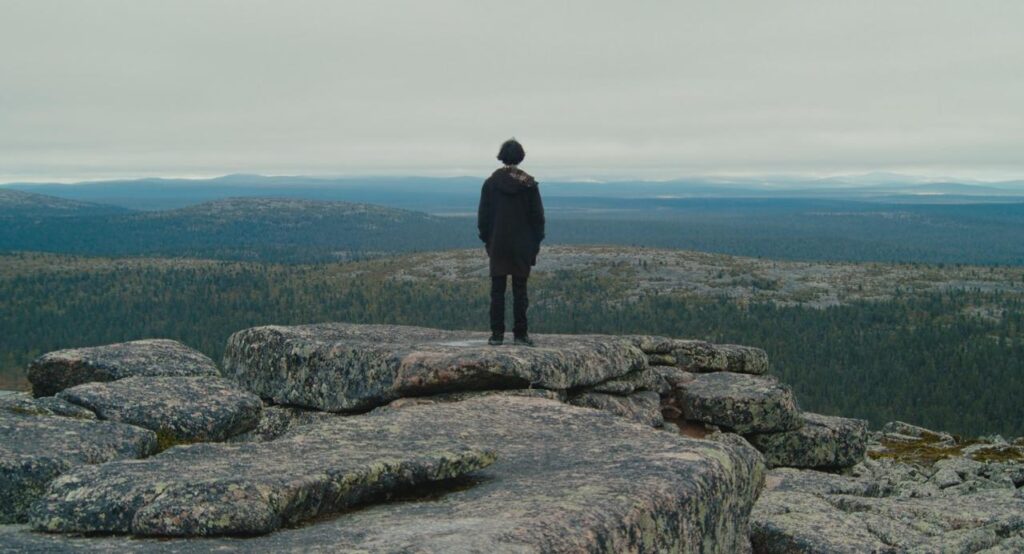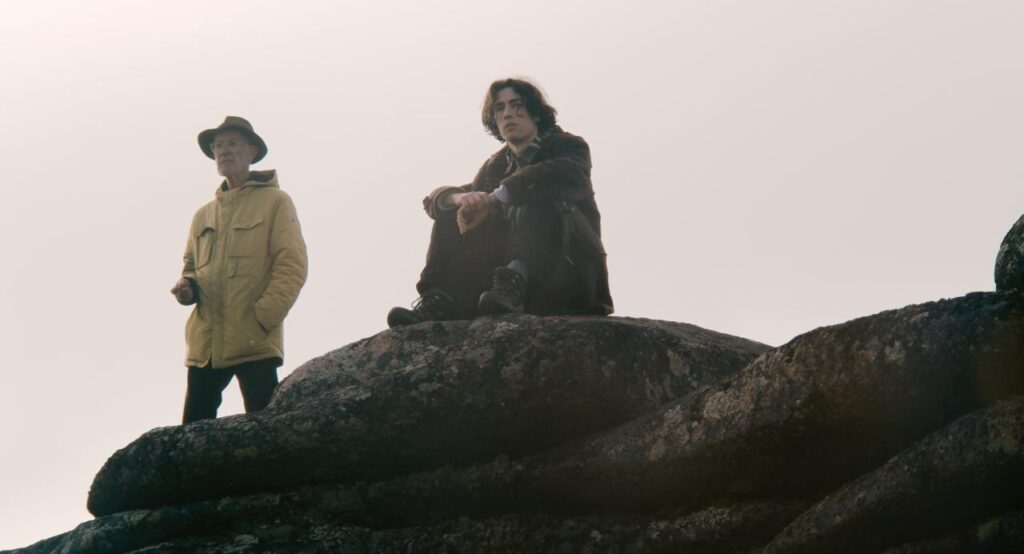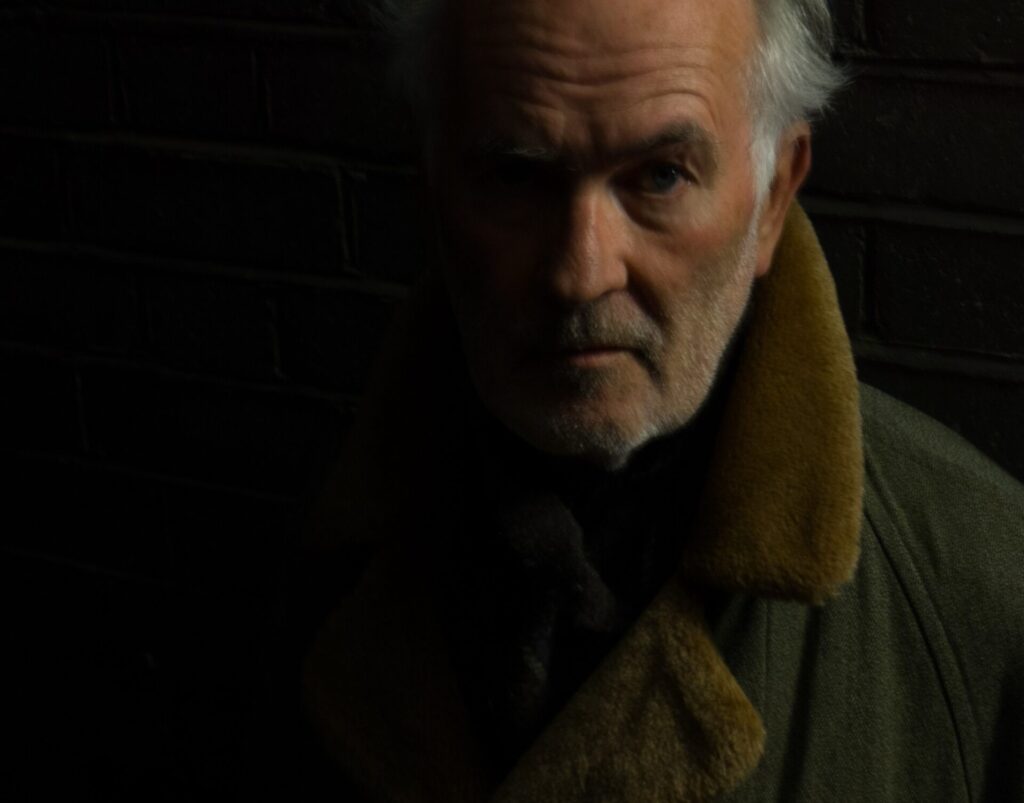Ever since establishing himself with his films Radio On (1979) and An Unsuitable Job for a Woman (1982), novelist and director Chris Petit has remained one of the most fascinating and forensic voices within British counter-culture. He published his first novel, Robinson, in 1993, influenced by J. G. Ballard and Louis-Ferdinand Céline – its story about a man working in the film industry in Soho, becoming involved in pornographic productions, reaffirmed Petit’s place within the psychogeographic movement alongside Patrick Keiller and Iain Sinclair. His later novels have explored the Troubles in Northern Ireland, and the Second World War – the drastic end of which forms the subject of his latest, Come In and Shut the Door.
Petit has continued to make films, returning with a documentary entitled D is for Distance, about his son Louis’ epileptic seizures, and his family’s struggle to secure medical cannabis to treat them. It’s a subtle and tender, yet formally innovative work that reflects on the nature of film itself, bringing in an eclectic range of references from CIA agent James Angleton to Betty Boop and Amanda Lear. Petit is now based in Rotterdam – I spoke to him via Zoom about both of his new works, and how they relate to the bleak contemporary political landscape.
Top of FormI’ll start with a question about Come In and Shut the Door, which draws a line from contemporary London to the Führerbunker and Hitler’s suicide, or apparent suicide, in 1945. What drew you to make this connection? And why do so in in fiction?
In 2016, I hadn’t published a novel since The Passenger, about Lockerbie, which came out in 2006. Then I spent several years writing a book, which was not commissioned, about a secretary in Auschwitz, looking at bureaucracy and mass murder. Then Martin Amis announced he was doing The Zone of Interest, and I said to my agent, Gillian Aitken, “that’s us dead in the water”. He said, “I think you’re probably right.” The subsequent success of the film has confirmed that. Anyway, in 2016, I met with Ian Chapman at Simon and Schuster, who’s published me since The Psalm Killer (1997) when he was at Macmillan. I said “I’m in a bit of a hole. I’ve written this book. It’s not for you. I’ve got no money, but maybe I can take the research I’ve done on it because I’d like to write about Germany in 1943-45. I managed to sell him two books, based on a real character called Conrad Morgan, who was an SS prosecuting judge, who effectively operated as a kind of SS internal affairs manager – perhaps naively given that Himmler based the SS on the Jesuits.
My editor at Simon and Schuster wanted to take the characters from my last book, a thriller called Ghost Country (2022), but the protagonist was a woman, and I didn’t have another story for her. I was interested in her sidekick, who announced that he’d studied in a seminary for a year before becoming a tax inspector, and I thought, “why did I say that?” I decided to start Come In and Shut the Door with him coming out of the seminary in 2010-11, and I wanted to fall in with somebody older and lush, so I wrote them. Then I thought, “What’s this other man’s background? “ and I realised, “it’s our old friend Robinson from 1993”. Rather than do Schlegel and Morgan go to South America, I wanted to gather the themes or threads of the last thirty years, and weave them into a story that spans several generations from the 1920s to the 2010s So it was a matter of inventing parents and grandparents for my characters, which was quite easy. I worked out that Schlegel, the other main character in the German books, was, in fact, Parker’s grandfather. As the three German novels had gone from 1943 to just after the failed assassination attempt on Hitler, the fourth was bound to end up in the bunker.
I’ve always been suspicious of the conventional account of Hitler’s marriage and death, based on Trevor Roper’s telling, which I thought was full of holes, so the novel was a chance to dig into that. And to give academic a good kicking.
The narrator also talks about Oliver Hirschbiegel’s film Downfall (2004), and the memes that came out of it, and compares it to G. W. Pabst’s The Last Ten Days (1955), which was the first post-war (West or East) German film to feature Hitler as a character. Can we talk about how film criticism comes into the novel?
There’s always been a slightly snotty attitude towards my career – critics don’t like it if you critics don’t like it if you do more than one thing, you’re seen as a jack of all trades. I started writing novels because I couldn’t carry on making films, due to the economic climate.do more than one thing, you’re seen as a jack of all trades. I started writing novels because I couldn’t carry on making films, due to the economic climate.
I came up with the idea for Robinson, but I thought, “I’m not a novelist. I haven’t done creative writing courses at East Anglia.” I thought of Robinson as a prose film, conceiving of a sentence as a tracking shot, or a cut. I couldn’t say to anyone, “I’m writing a novel.” – I didn’t have the wherewithal. But reading the English novel, more than the British novel, I felt a real lack of contemporary reference, like I could have been reading something from 1890. There were a few exceptions, like Ballard, dealing with a modern world, but on the whole, that wasn’t the case. Why not put Eric Burdon or David Bowie in it?
The film criticism came in because I watched those films when I was researching the bunker, and thought Parker is entitled to have his opinion on them. It was enjoyable, writing about film, and the Pabst (unlike Downfall) was a revelation.
Parker, the central character in a huge cast, has his life marked a skin condition, and by the abuse he suffers at the hands of a priest, in an institution that refuses to believe him. The title, Come In and Shut the Door, suggests these abuses taking place in private – but I’m interested in how you created Parker, and handled the effects of these things on him.
There’s a background in my family of eczema and psoriasis. I wanted to create a character who would find it difficult to integrate because of how people reacted to him, or people looked at him, so he was an outsider.
I was educated by Roman Catholic monks. I went through the process unscathed, but my next school was subject to the exposure of great scandals. I never got organised religion. I thought they were great stories, but I never believed it. Strangely, my school was very authoritarian, but it was also quite liberal, because once you were 16 you were allowed to drink and smoke, and the only the only reason I climbed the greasy pole was that the more power you had, the more you could smoke.
I think institutional abuse and misogyny are the two great fault lines of history, and that the history of the Vatican in the Second World War, and this sense of returning to this Christian fundamentalism in the United States, I thought these are frightening times, with many of our problems having their origins in the second half of the 20th century, when I grew up. We thought the war was a big dividing line but actually, it was mostly seamless – much of the Nazi system was preserved, same judiciary, same teachers. It’s useful to point out the continuity. From that period, I like the novels of Eric Ambler, that whole geopolitical explanation of the world. I’m more interested in that than I am in a man or a woman, or who did this or that.
Let’s talk about Robinson, because he recurs in your works, and for years people assumed he was autobiographical. It’s obvious in Come In and Shut the Door that he’s not – but how did you shape Robinson for this particular work?
Robinson was based on the character in Louis-Ferdinand Céline’s Journey to the End of the Night, functioning for me like a kind of passive observer, a camera. Like the Robinson in Céline’s novel, mine was always one step ahead of the story, waiting for the narrator. Over the years, I’ve been asked if I would ever revive Robinson, but I didn’t have a story.
I was talking to Iain Sinclair in 2011, because we were tramping around a site that was going to become the venue for the Olympic Games. He said he thought Robinson had “the handshake of a spoiled priest”. I remembered that line. I thought he probably hob-nobs with Bono and Bob Geldof. I thought about money laundering and quangos – I wrote a couple of pages but couldn’t find an angle, and it wasn’t until I wrote Come In and Shut the Door that I thought he was a bit like an actor, like Christopher Walken. He’s doesn’t star in films any more, but he comes in for two weeks, collects his money and leaves. I wanted to use Robinson like a character actor.
When Parker first goes to Kilburn, to see someone whose house is full of old junk, I didn’t have Robinson in mind. I just needed to invent a backstory. I had the idea of this mad Russian which was based on this extraordinary film Dau, which my wife, Emma Matthews, worked on for about six weeks, but eventually it became Robinson – he had the right age and profile.

Regarding both Come In and Shut the Door and your new film D is for Distance, I’m like to know how you feel about the relationship between autobiography and fiction in your work, and how audiences receive it with that in mind.
There was always the assumption that Robinson was an autobiographical novel, which it never was. I can see why, because it was in the first person, and conformed to a geography that I knew, but it was based less on London, though I thought Soho was an interesting location for what it represented, but it was based more on time I spent in Berlin, which was a much more concentrated city because it had a big wall around it. It was heavily subsidised as a showcase for the West. It was very permissive within that context, unlike anywhere else in the world. Nobody ever told you to go home. Although I was more of an observer than a participator, I thought, “this is all interesting material”, so it was a matter of transposition. I didn’t want to write a novel about my experience of West Berlin, but it would be more interesting to take my observations and transpose them onto London. One review, I think in The Guardian, referred to the character being called Christo, which reinforced the idea that I was writing about myself.
I’ve used myself in film like Content (2010) and in D is for Distance, which is largely based on our son’s epilepsy, which he contracted out of the blue. In 2016, when he was 12, he went through two terrible years with the NHS. His mother took him to Rotterdam for cannabis, medication, and against all predictions, his seizures stopped. A happy ending, except we’re now in our fourth or fifth year of trying to get a prescription, to which he is entitled, from the NHS. Others are suffering from the same kind of blockages. Emma was writing about it, as a way of trying to keep herself sane. We cut a ten-minute film for crowdfunding, and realised we wanted to make something longer – but I was insistent that it wasn’t a first-person film. It’s a story of something that can happen to any mother’s child – both personal and universal. As a result, we are in the film, but should be viewed in our symbolic roles as father, mother and son, appearing because it’s cheaper than hiring actors to play us. I’ve never written a character based on myself in my novels, and if I appear in my films – which I do as little as possible – then it’s as a kind of representative of the narration more than anything else.
There are other stories running through D is for Distance, such as that of James Angleton and the CIA’s use of LSD. Why focus on Angleton in particular?
It goes back to the question of: how do you get a film made? I didn’t want to make a standard documentary about epilepsy. Based on the trailer, I managed to interest German and French television – ZDF and Arte. I think the woman at ZDF was demob happy because she was about to retire, and she commissioned the film on the back of the trailer. So, I had a certain amount of money, but you need a production company to deal with a television station, and I’ve never had one. I’d been talking to a Finnish film company because Mika [Taanila], the producer, had invited me to do something at the Oberhausen Film Festival. It had to take place in a cinema where you weren’t allowed to show anything. I came up with this project called Lee Harvey Oswald’s Last Dream, which he really liked. He talked about us working together, but I could never come up with anything to his satisfaction, in terms of raising money in Finland. When ZDF came on board, I asked if he would be interested in producing the film. He asked if I could work in a Finnish angle.
I’d be talking to him about this James Angleton project, and a script called The James Jesus Tapes, which was going to be made into a film – I’d even spoken to Christopher Walken about it, but nothing happened. So in 2018, I turned it from a film project into a taped project for an actor, like Krapp’s Last Tape, recorded on a boombox and cassettes. For this Finnish project, I thought we could look at Angleton at the end of his life, going to the Arctic Circle to fish as he was a world-class fly fisherman, and he makes some recordings in a remote hut. I suggested Mika find a location, and he came back with some great material.
So, I had this unrealised project, and this film about epilepsy. It was a matter of putting these elements together – I have a history of making road movies, but I suggested a journey film that goes from London to the Arctic Circle, with a father travelling with his son by boat, to search for this location concerning an old spymaster. Somehow, Mika actually raised Finnish money for it – the budget wasn’t huge, but we all got paid.

D is for Distance uses archive footage from early films by Georges Méliès and Louis Le Prince, and some less familiar ones, as well as the Betty Boop cartoons, footage of Angleton, and more. How did you choose this footage? What was the process of sourcing it like?
Trial and error. Mika asked if I wanted to spend the development money on writing a script and I said, “Good Lord, no!” Instead, we shot what we could of the journey to Finland, and a couple of days there. I wanted the ending of the film to be slow, dumping that Instagram swipe culture, with a sense of rediscovering cinema with the scenes being properly shot. The journey was to arrive at a certain formal aesthetic. On the first day, we couldn’t go up the hills because it was raining, and we were wandering around the location. We discovered this fake Western town, just standing there. We had no idea it was there, and we could have easily missed it. We had an afternoon of improvising shots, thinking about Once Upon a Time in the West, and David Bowie in The Man Who Fell the Earth. We were aware that we were dealing with scraps, and we discovered that the Eurostar was very uncinematic, sort of filler material. Emma had worked with Anthony Wall from BBC Arena, which he produced for years, on this film called Night and Day, which was a twenty-four-hour film that that used archive material from 600 hours’ worth of Arena, so at lunchtime it was lunchtime, at sunset it was sunset, rather like The Clock by Christian Marclay.
It used this loophole called ‘pastiche’ – I wrote a piece years ago for Sight and Sound, which occasionally gets republished, called Flickers, which is just scenes from films jammed together. Given my background as having written about film under the heading of pastiche, I thought we could introduce clips under that condition, but the Finns don’t have that loophole, so everything had to cleared. Talking about medication, I wanted to use the Ferris wheel scene from The Third Man, where Orson Welles points at these little figures and asks who would miss any of them if they disappeared. It was good in a preliminary cut, but we were told it would cost £15,000 – we couldn’t use it. Mika suggested taking things that were in the public domain – it’s okay, but an approximation of what I wanted. But it worked well – the Joan of Arc hand-tinted scenes were trippy in the way Louis’ withdrawals experiences from medication were trippy. A friend said the film was tripped-out but stone cold sober – I liked that.
I wanted to use music, but it’s not like when I made Radio On (1979), when you could badger Kraftwerk into giving you their work for £50 a track. We had this woman in Finland clearing these rights, and it was a nightmare – we would lose stuff even after we delivered the cut. We had a scene where Louis’ on the bus, having got off the boat, following a van which says ‘follow me’. We used the song by Amanda Lear – initially they approved it, then put up the price. It was back-to-back with ‘Boys in the Better Land’ by Fontaines D.C., and then the same thing happened with that, so we lost it. We had the same problem with Betty Boop – in the public domain in the US, but not in Europe. The producer found a site that sells material with world clearance rights, including Betty Boop Blues and the Cab Calloway song we wanted, so we put them back in. But short answer – never get involved with a film that requires music clearance – none of us ended up getting as much money as we should, because of that.
I picked up on the lines near the end about how life doesn’t often fit character arcs and the other narrative conventions of film, but instead “it’s just time running out” – I found it poetic. I wondered how you came to that conclusion in the dialogue.
It was an episode of The Sopranos where Christopher is trying to write a script and he said he wanted to know what was his own character arc. At bottom, films remain essentially quite conservative, with critics writing about stories of men and women, or whether they ‘relate’ to the characters, etc. Which is why I’ve always liked the American critic Manny Farber, because he didn’t think about film in that way. When I was reviewing films, I was always hopeless at following the plot, so I avoided synopsis as much as possible.
It felt like there was a paradigm shift in 2016, with Brexit, Trump, and Louis starting to have seizures. The whole world changed, not just ours, and looking back, we were in what I’d call a pre-pandemic situation. I thought there was going to be a Biblical disaster. David Bowie dying was the preface of that – there was even a Downfall parody where Hitler talks about it.
Another thing in the film – I’m fascinated by the acceleration of technology happening at the same time as the re-establishment of religious fundamentalism. I remember Trump referring to himself as a horseman of the Apocalypse – I’m not going to be around for that much longer and I worry what the world will be like for my two sons. The left has no political projects and Europe’s been in statis for decades. I always thought the fall of the USSR would reopen a lot of conflict that had been dormant for forty years, and so it’s proved. You throw climate change and its denial into that, and I do have a sense of time running out.
Come In and Shut the Door by Chris Petit is published by Simon & Schuster




